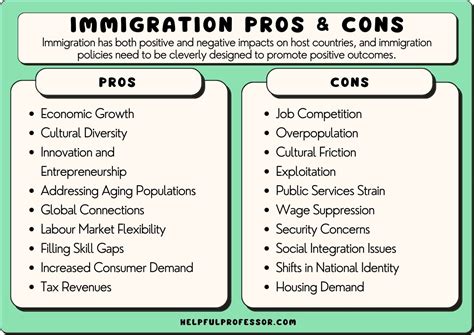Immigration is a complex and multifaceted phenomenon that has shaped societies around the world for centuries. While it undoubtedly brings certain benefits, it also presents a range of negative consequences that cannot be ignored. This essay aims to delve into the often-overlooked adverse effects of immigration, examining its impact on social, economic, and cultural dimensions.

Economic Effects
1. Increased Unemployment and Wage Suppression:
Mass immigration can lead to an influx of workers competing for a limited number of jobs, resulting in increased unemployment and downward pressure on wages. According to the Pew Research Center, the influx of low-skilled immigrants in the United States has depressed wages for native-born workers by 1-3%.
2. Strain on Public Resources:
Immigrants often rely on government services, such as education, healthcare, and welfare, which can strain public resources and increase the tax burden on existing citizens. The Congressional Budget Office estimates that immigrants and their native-born children will cost American taxpayers $2.3 trillion over the next decade.
Social Effects
1. Cultural Assimilation and Identity Erosion:
Large-scale immigration can challenge established cultural norms and values, leading to a sense of identity loss among the original population. As immigrants integrate into society, they may bring their own customs and traditions, which can create tensions and divisions within communities.
2. Social Unrest and Conflict:
In certain cases, immigration can exacerbate existing social and economic inequalities, leading to resentment and conflict between immigrants and native citizens. Competition for jobs, housing, and resources can fuel tensions, sometimes resulting in violence and social unrest. For example, the rise of anti-immigrant sentiment in Europe has been linked to a backlash against perceived threats to traditional values and livelihoods.
Cultural Effects
1. Homogenization and Cultural Loss:
Mass immigration can lead to the homogenization of cultures as different ethnic groups interact and assimilate with each other. This can result in the loss of unique cultural practices, languages, and traditions, particularly in smaller or marginalized communities.
2. Language Barriers and Integration Challenges:
Language barriers and cultural differences can hinder effective communication and integration between immigrants and native citizens. They can limit job opportunities, access to healthcare and education, and overall social participation, leading to social isolation and a sense of alienation among immigrant communities.
Policy Implications
Addressing the negative effects of immigration requires a comprehensive and balanced approach. While it is important to recognize the benefits of immigration, it is equally crucial to mitigate its potential drawbacks. Here are some policy recommendations:
1. Managed Immigration Flows:
Governments should implement policies to regulate and manage immigration flows to prevent excessive pressure on public resources and social integration capacity. This may involve setting quotas on the number of immigrants admitted based on labor market needs and social welfare considerations.
2. Integration and Assimilation Programs:
Invest in programs that promote integration and assimilation of immigrants into society. This includes language classes, cultural orientation, and employment training to facilitate their participation in the workforce and community.
3. Labor Market Policies:
Implement labor market policies that protect the wages and job security of native workers while also ensuring that immigrants have access to fair and decent work. This may involve minimum wage laws, training programs, and enforcement of labor standards.
4. Social Welfare Reform:
Reform social welfare programs to ensure that they provide adequate support for both immigrants and native citizens without creating disincentives for work or integration. This may involve targeted assistance for vulnerable immigrant populations while also promoting self-sufficiency and economic independence.
Conclusion
Immigration is a complex issue with both positive and negative implications for society. While it can bring fresh perspectives, skills, and economic growth, it is important to acknowledge and address the potential adverse effects it can have on various dimensions of life. By adopting balanced and evidence-based policies that manage immigration flows, promote integration, and protect the interests of both immigrants and native citizens, societies can mitigate the negative consequences of immigration while harnessing its benefits for the common good.
